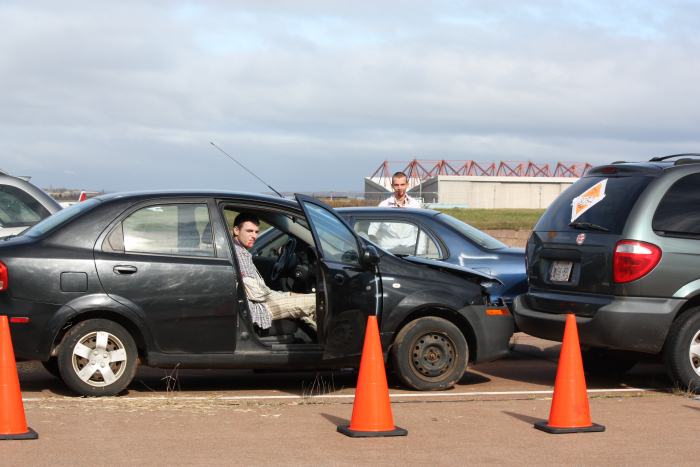There’s an 11-vehicle pile-up on the old runway. A body is sprawled across the ground next to a crushed motorcycle as a wisp of smoke spirals upward. A cable snakes away from a downed power pole. People with injuries ranging from broken bones to head wounds sit in the twisted wreckage or wander around as though dazed. Propane tanks are scattered on the ground. The smell of diesel fuel hangs in the air.
 The only sound is the buzz of a UAV, or drone, as it hovers over the scene.
The only sound is the buzz of a UAV, or drone, as it hovers over the scene.
A voice cuts through the buzzing, coming from a built-in speaker onboard the UAV.
“If you can walk, please wave your hand.”
Two of the injured wave their hands.
“Move toward the grass,” the voice instructs them. The two men move away from the wreckage onto the grass that fringes the runway.
“If you are conscious, but can’t get out of your car, please wave,” the voice continues. A few more of the injured signal that they have heard and can respond to the request.
The UAV turns and flies toward a tent some metres away, softly landing on a concrete pad as a paramedicine student accompanied by a preceptor and an adjudicator walks confidently toward the wreckage.
This is a simulation of a mass casualty incident held on an unused runway at Slemon Park, part of a unique applied research project.
Dr. Trevor Jain, medical director of the Holland College paramedicine programs, program director for the new Bachelor of Science in Paramedicine program at UPEI, and chief researcher for the project, explains why it is unique.
“There is anecdotal information about people using UAVs during mass casualty incidents and natural disasters to see what’s going on, but there hasn’t been any research done on the efficacy of using UAV technology as an assessment tool. This is the first applied research in this field in the world,” he says.
The project, which is being led by Holland College’s applied research department, includes UPEI, the Canadian Armed Forces, Island EMS, industry partner Skymetro and some 70 people.
Students from both first and second year Primary Care Paramedicine program were given three tasks. First, to assess the scene to identify potential hazards, second, to triage the injured, and third, to allocate resources. Half of the students performed these tasks the usual way, by walking around the scene; the other half assessed the scene using information collected by the UAV piloted by a trained technician. In the case of the triage exercise, the students using the information from the UAV would then proceed to the site to finish triaging and to allocate resources. These exercises were conducted in daylight and at night to gather as much data as possible.
By using UAVs to do the initial site assessment, first responders are not exposed to hazardous materials, unstable structures such as overturned cars, potentially explosive materials, or armed assailants. The purpose of the research is to determine whether first responders using UAV technology could accurately assess situations remotely in the same amount of time or less than they do by walking through a site.
When the research is complete, first responders will be able to determine whether the addition of a UAV and trained technician to their mass casualty incident team would be beneficial for their team, and for the injured.
For more information, please contact:
Sara Underwood, Media and Communications Officer
Tel: 902-566-9695
Date: October 20, 2016